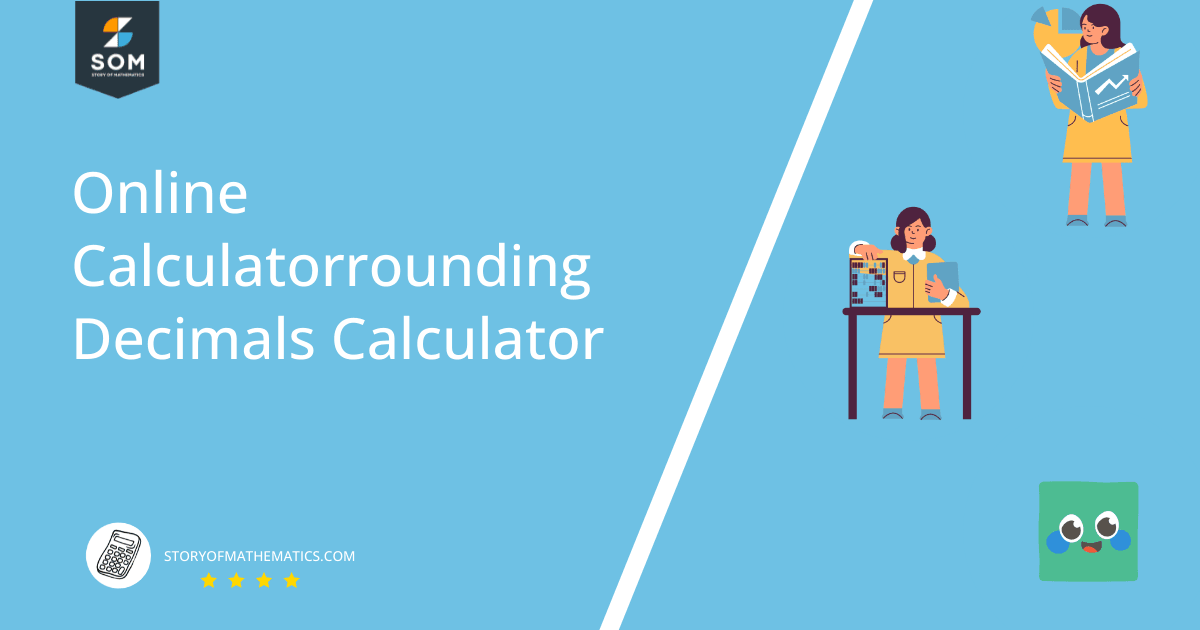JUMP TO TOPIC
Rounding Decimal Calculator + Online Solver With Free Steps
The Rounding Decimal Calculator rounds any given decimal number to the desired number of digits. It uses the standard rounding rules to do this.

What Is the Rounding Decimal Calculator?
The Rounding Decimal Calculator is an online tool that uses the standard rounding rules to round any decimal number to the specified number of digits.
The calculator interface consists of two text boxes labeled “round” and “decimal places.” In the first one, you enter the decimal number. In the second one, you enter the number of decimal places to which you want to round that decimal number.
How To Use the Rounding Decimal Calculator?
You can use the Rounding Decimal Calculator to round any decimal number to n digits by simply entering the decimal number and the number of digits to keep. Follow the step-by-step guidelines below to use the calculator correctly.
Step 1
Enter the decimal number in the first text box, “round.”
Step 2
Enter the number of decimal places to keep in the second text box, “decimal places.”
Step 3
Press the Submit button to get the results.
Results
The results show as an extension to the calculator’s interface and contain two sections named “Decimal form” and “Number line.” The former is the rounded decimal result, while the latter depicts it on the number line.
How Does the Rounding Decimal Calculator Work?
The Rounding Decimal Calculator works by following the standard rounding rules for decimal numbers. Let us take a look at those below.
Rounding Rules for Decimal Numbers
Suppose n is the number of decimal places to round to and is not equal to the number of decimal digits in the given number. Then, the only digit of interest is the one right after the n$^\textsf{th}$ decimal digit. Let us call this the n+1 decimal digit.
Depending on the value of this n+1 digit, there are a total of four possible actions based on three rules:
- n + 1 is greater than 5: The value of the n$^\textsf{th}$ digit increases by 1.
- n + 1 is smaller than 5: The value of the n$^\textsf{th}$ digit remains unchanged.
- n + 1 is the last decimal digit and equal to 5: If the value of the n$^\textsf{th}$ digit is an odd number, then it increases by one. If the value of the n$^\textsf{th}$ digit is an even number, then it remains unchanged.
Five as the Pivot
Our goal when rounding numbers is to keep the rounding error minimum.
Consider the sequence of digits 0–9 (ten digits with no perfect middle). However, notice that if 0 is the n+1 digit, it does not contribute anything because 5.1230 and 5.123000 are the same as 5.123!
The above fact allows us to eliminate 0 from the sequence. Now, we have 1–9 (nine digits and a perfect middle at 5). Therefore, 5 is a logical pivot for our rounding decision.
Verifying Rules 1 and 2
Consider that you want to round the following numbers to one decimal place: 1.74 and 1.76. Now you have two choices for both numbers: keep the first decimal digit (7) unchanged or increase it to 8. Let us check the error for both numbers:
- For 1.74, 4 < 5, so it would become 1.7 when rounded, which gives an error of |1.7 – 1.74| = 0.04. If we instead rounded up to 1.8, the error would be |1.8 – 1.74| = 0.06, which is greater than 0.04!
- For 1.76, 6 > 5, so it would be 1.8 when rounded, which gives an absolute error of 0.04. If we instead kept it at 1.7, the error would be 0.06, which is greater than 0.04!
Therefore, the first two rules are valid and minimize the rounding error.
Understanding Rule 3
What if the n+1 digit is 5? In this case, we will get the same error whether we leave the n$^\textsf{th}$ digit unchanged or increase it. For example, consider 7.55. To round to one decimal place, we can go with either 7.5 or 7.6 because both give the same absolute error of 0.5.
However, if we made rules like “always round up” or “always round down,” the total rounding error would stack. A better choice would be to round down half of the time (-0.5 error) and up the other half (+0.5 error). That way, we would hopefully average out the rounding error.
The next question is how to maximize our chances of averaging out the error. Notice that the n$^\textsf{th}$ digit can be 0–9. This sequence has the same number of even (0, 2, 4, 6, 8) and odd numbers (1, 3, 5, 7, 9). What if we rounded down on even and up on odd-numbered values of the n$^\textsf{th}$ digit? Well, we just described Rule 3!
It is also sometimes called “the rule of 5.” If the n+1 digit is not the last decimal digit, consider all digits after it and use either Rule 1 (most probable) or Rule 2.
Solved Example
Example 1
Round 3.43551975 to one, three, five, and seven decimal places.
Solution
For one decimal place, we can see that the second decimal digit is 3. Since 3 < 5, we round down to 3.4.
For three decimal places, notice that the third and fourth decimal digits are both 5. However, the fourth decimal digit is not the last one, so we cannot apply Rule 3. We can see that the lost decimal part is 0.51975 > 0.5, so we use Rule 1 and round up to 3.436.
For five decimal places, the 6th digit is 9 > 5, so we round up to 3.43552 (per Rule 2).
For seven decimal places, see that the seventh and eighth digits are 7 and 5, and 5 is the last digit. Thus, we must use Rule 3. Since 7 is an odd number, we round up to get 3.4355198.
